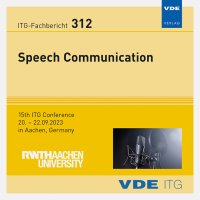Exploiting an External Microphone to Improve Time-Difference-of-Arrival Estimates for Euclidean Distance Matrix-Based Source Localization
Konferenz: Speech Communication - 15th ITG Conference
20.09.2023-22.09.2023 in Aachen
doi:10.30420/456164002
Tagungsband: ITG-Fb. 312: Speech Communication
Seiten: 5Sprache: EnglischTyp: PDF
Autoren:
Bruemann, Klaus; Doclo, Simon (Department of Medical Physics and Acoustics and Cluster of Excellence Hearing4all, University of Oldenburg, Germany)
Inhalt:
Recently, a Euclidean distance matrix (EDM)-based 3D source position estimation method was proposed, which relies on estimated time-differences-of-arrival (TDOAs) between microphones with a known array geometry. These TDOAs are often estimated by determining the time lag that maximizes the generalized cross-correlation with phase transform (GCC-PHAT) function for each microphone pair. In noisy and reverberant environments, the time lag corresponding to the direct source component may no longer correspond to the maximum of the GCC-PHAT function, which leads to TDOA estimation errors and consequent source localization errors. In this paper, we assume the availability of an external microphone at an unknown position in the vicinity of the source, in addition to the microphone array, hence, typically having a high direct source component relative to the noise and reverberation. Aiming at improving the reliability of the GCC-PHAT function, we propose a new approach to compute the GCC-PHAT function for each microphone pair in the array by convolving the GCC-PHAT functions between the external microphone and the respective microphones in the array. Experimental results demonstrate that incorporating an external microphone enables a significant improvement in the source localization performance of the EDM-based method, when the external microphone is close enough to the source.


